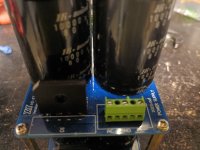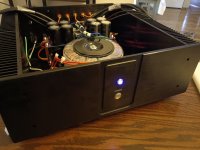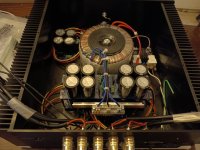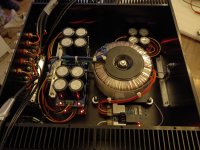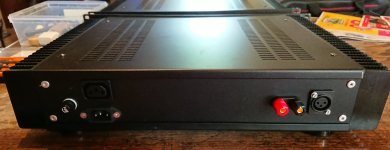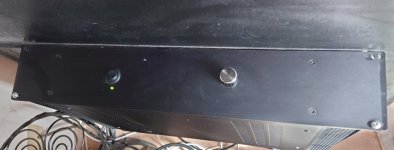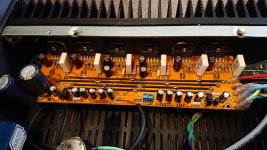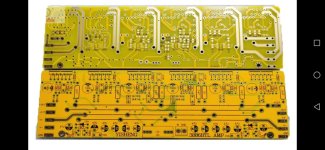These were the terminals I was able to find on Mauser they say they'll take up the 14 gauge but I can't even get a piece of 14 gauge in there successfully and I'm realizing if I take these out and solder I'm not sure if I'll get a 14 gauge wire in the soldering hole on the board. The soldering post of these terminals are 7 mm does anyone know where I could find a bigger terminal block that's suitable for what I'm trying to do that could at least take up to a number 12 so it could accommodate my 14 gauge for sure.
Attachments
Yeah. Those terminals are fairy small. The ones I use on the Power-86 and -686 take up to AWG 10 if I recall correctly.
You'll get the best connection with a crimp terminal as long as you can get a good and gas-tight crimp. The latter bit is often overlooked by DIYers who crimp using those stamped metal crimp tools that come for free when you buy a set of spade terminals.
Connectors are pretty reliable these days. I use the same JST connectors as Hypex in the Modulus-686. I'm not worried about failure. I do not offer the Modulus-686 without the connectors. The connectors lock in place in the PCB so they will be really difficult to remove and you run the risk of damaging the board by removing the connectors.
Tom
You'll get the best connection with a crimp terminal as long as you can get a good and gas-tight crimp. The latter bit is often overlooked by DIYers who crimp using those stamped metal crimp tools that come for free when you buy a set of spade terminals.
Connectors are pretty reliable these days. I use the same JST connectors as Hypex in the Modulus-686. I'm not worried about failure. I do not offer the Modulus-686 without the connectors. The connectors lock in place in the PCB so they will be really difficult to remove and you run the risk of damaging the board by removing the connectors.
Tom
Power supply complete no magic smoke no fireworks. everything looks good on the oscilloscope nice clean output. Now I got to save up for the amp modules which I'm extremely excited about. still haven't even purchased the speakers or finish the room the amp is going in so it's going to be a minute probably mid late summer.
Attachments
Hello
I have Kinoshita RM11 replica speakers, bi-amplified by 4 mono blocks attached to the back of the speakers....the compression chambers are powered by 2 amplifiers mono based on Neurochrome Modulus 86, and 40cm bass by 2 amps mono based on basic LM3886 modules......
my amps were built 3 years ago by a technician who disappeared into thin air !!!
my bass amps with currently the basic LM3886 modules work on my speakers up to 480hz......the Modulus 86 taking over on the mid-treble.....Will there be a gain by changing the LM3886 by Neurochrome Modulus 686?
Would it be easy to change the basic BTL modules of the bass amps with Modulus 686?
I would like to point out that I am not a technician, but I have a friend who is, and to whom I would show this post

I have Kinoshita RM11 replica speakers, bi-amplified by 4 mono blocks attached to the back of the speakers....the compression chambers are powered by 2 amplifiers mono based on Neurochrome Modulus 86, and 40cm bass by 2 amps mono based on basic LM3886 modules......
my amps were built 3 years ago by a technician who disappeared into thin air !!!
my bass amps with currently the basic LM3886 modules work on my speakers up to 480hz......the Modulus 86 taking over on the mid-treble.....Will there be a gain by changing the LM3886 by Neurochrome Modulus 686?
Would it be easy to change the basic BTL modules of the bass amps with Modulus 686?
I would like to point out that I am not a technician, but I have a friend who is, and to whom I would show this post
I'm curious if any of you use the Modulus-686 + Modulus-286 combo with a Linkwitz LX521.4.
A customer is looking for someone with experience with such a build to answer a few questions about the experience and results. If you have heard the LX521.4 with the Modulus-686 and '286 combo would you either post your experience here or email me (add @neurochrome.com to my user ID here) so I can introduce you to my customer?
Thanks,
Tom
A customer is looking for someone with experience with such a build to answer a few questions about the experience and results. If you have heard the LX521.4 with the Modulus-686 and '286 combo would you either post your experience here or email me (add @neurochrome.com to my user ID here) so I can introduce you to my customer?
Thanks,
Tom
The Modulus 686 without question is a better concept than the PCB you use. Anyway, even these are very good amps if no one messed them up. The advantage and danger of most Chinese copy stuff is that the copy cat has no clue what he does. So many are 1:1 copies of good Western amps, which is good. When the Chinese "Developer" get's creative, things get worse, as they only improve the cost of a copy and remove parts they consider unnessecary.
These 6x3886 boards should work quite well and have lots of current to drive bass chassis.
I don't see (sorry Tom) any audible advantage from replacing them for 480 Hz limited bass work on your active speaker.
Your amp doesn't look that nice I would consider just swaping the YISHENG for a Modulus 686 without a major, professionel clean up. Which would result in a 90% new build of the amp. Anyway, you have the LM3886TF modules, so you can recycle them for a modulus, saving about 90$ on both.
The final sound quality of an amp is not only a nice LM3886 PCB with good components, but any other part used, starting at the input connectors and ending at the binding post. Just close the cover of your amp and never show it from the inside again.
These 6x3886 boards should work quite well and have lots of current to drive bass chassis.
I don't see (sorry Tom) any audible advantage from replacing them for 480 Hz limited bass work on your active speaker.
Your amp doesn't look that nice I would consider just swaping the YISHENG for a Modulus 686 without a major, professionel clean up. Which would result in a 90% new build of the amp. Anyway, you have the LM3886TF modules, so you can recycle them for a modulus, saving about 90$ on both.
The final sound quality of an amp is not only a nice LM3886 PCB with good components, but any other part used, starting at the input connectors and ending at the binding post. Just close the cover of your amp and never show it from the inside again.
The amps are really very, very good on the bass.....even if it's true that the interior is a bit messy.....the exterior is very correct...in any case we don't see them since they are attached to the back of the speakers
Attachments
I actually do. I could swear I wrote a response to @Alfachris but I don't see it here, so I guess it slipped my mind. Anyway.I don't see (sorry Tom) any audible advantage from replacing them for 480 Hz limited bass work on your active speaker.
I do see an advantage of using a clean amp even for low midrange or upper bass. Keep in mind that the fundamental of male vocals tend to sit around 100 Hz whereas that of females around 180 Hz. So 480 Hz would cover up to the 2nd to 4th harmonic of human voices. I'd argue that's pretty important to render cleanly.
It would be pretty straight-forward to swap out the module seen above for the Modulus-686. Reuse the power supply and the chassis.
Are you sure those amp modules are BTL? They look like six LM3886es in parallel Jeff Rowland style. I don't see anything to invert the phase of one half, but could easily be missing something.
Tom
Last edited:
And we all know that products from Aliblahblah always live up to their markings, right? 🙄
I'm willing to bet that the four wires on top of the board are connected to V+, GND, V-, and OUT. If the amp was BTL, there would be five wires: V+, GND, V-, OUT+, OUT-. There would also be circuitry to invert the phase on one half of the amp, unless it's connected in an inverting configuration. The latter is possible, but that gives you pretty low input impedance.
I'm perfectly willing to be proven wrong here.
You can verify pretty easily: Apply a test tone to the amp and measure the voltage from OUT+ to ground. Then measure from OUT- to ground. You should see the same voltage if the amp is a BTL amp. If OUT- connects to ground then it's a single-ended amp, i.e., not a BTL amp.
Tom
I'm willing to bet that the four wires on top of the board are connected to V+, GND, V-, and OUT. If the amp was BTL, there would be five wires: V+, GND, V-, OUT+, OUT-. There would also be circuitry to invert the phase on one half of the amp, unless it's connected in an inverting configuration. The latter is possible, but that gives you pretty low input impedance.
I'm perfectly willing to be proven wrong here.
You can verify pretty easily: Apply a test tone to the amp and measure the voltage from OUT+ to ground. Then measure from OUT- to ground. You should see the same voltage if the amp is a BTL amp. If OUT- connects to ground then it's a single-ended amp, i.e., not a BTL amp.
Tom
Ah. I stand corrected then. The circuitry I was looking for is on the bottom of the board.
Tom
Tom
The SMPS300REh (±30 V) will power a stereo Modulus-86 amp for music signal. It does run out of oomph during sine wave testing with a 4 Ω load. Also note that you may have to solder the 1/4" spade tabs on the output as they're often not soldered fully to the board. You can do that from the top of the board.
I'd think the SMPS500RxE or SMPS600RxE would provide enough power even for sine wave testing (again assuming stereo Modulus-86) but they don't come in ±30 V. Connex does offer a custom option that's a few bucks more but I don't know if they can go as low as ±30 V. That's a question for Connex.
For the Modulus-686, the Connex SMPS800RE in a custom ±36 V option (which they can make) would be my go-to. That'll power a stereo Modulus-686 with music signal and a 4 Ω load. Micro-Audio likely has some options that'll work well too, though I'm not far enough in my evaluation to be able to recommend a specific model.
Tom
I'd think the SMPS500RxE or SMPS600RxE would provide enough power even for sine wave testing (again assuming stereo Modulus-86) but they don't come in ±30 V. Connex does offer a custom option that's a few bucks more but I don't know if they can go as low as ±30 V. That's a question for Connex.
For the Modulus-686, the Connex SMPS800RE in a custom ±36 V option (which they can make) would be my go-to. That'll power a stereo Modulus-686 with music signal and a 4 Ω load. Micro-Audio likely has some options that'll work well too, though I'm not far enough in my evaluation to be able to recommend a specific model.
Tom
Thank you for the detailed reply, Tom! Your amps just caught my attention a few days ago & they really do seem tops. Am tempted to build some -- not because I need them but because I need to hear if they make significant differences as some of your user reviews have stated.
I also found a long lost pair of Antek AN-7240 toroidal transformers, purchased for a project abandoned 20+ years ago. They are 700VA, dual 40V output (4 wires). Can it be used in a PSU for your 686 amp?
I also found a long lost pair of Antek AN-7240 toroidal transformers, purchased for a project abandoned 20+ years ago. They are 700VA, dual 40V output (4 wires). Can it be used in a PSU for your 686 amp?
Yeah. You'll want 2x25 VAC for the Modulus-686. 500-800 VA would be appropriate for a stereo amp.
Tom
Tom
- Home
- Vendor's Bazaar
- Modulus-686: 380W (4Ω); 220W (8Ω) Balanced Composite Power Amp with extremely low THD
